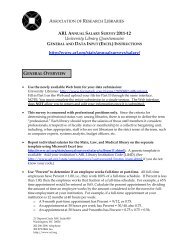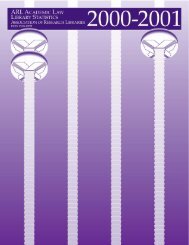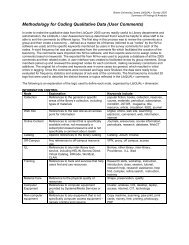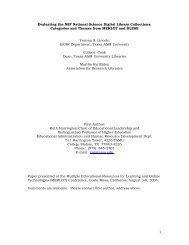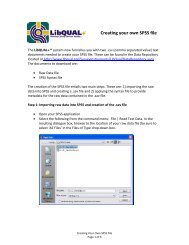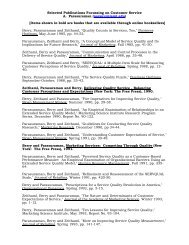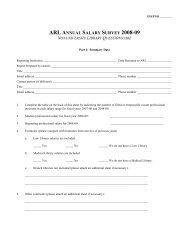You also want an ePaper? Increase the reach of your titles
YUMPU automatically turns print PDFs into web optimized ePapers that Google loves.
INTRODUCTIONThe <strong>ARL</strong> <strong>Annual</strong> <strong>Salary</strong> <strong>Survey</strong> <strong>1999</strong>-<strong>2000</strong> reports salary data for all professionalstaff working in <strong>ARL</strong> libraries. The Association of Research Libraries (<strong>ARL</strong>) representsthe interests of 121 libraries that serve major North American research institutions. 1The Association operates as a forum for the exchange of ideas and as an agent forcollective action to influence forces affecting the ability of these libraries to meet thefuture needs of scholarship. The <strong>ARL</strong> Statistics and Measurement program, whichproduces the salary survey, is organized around collecting, analyzing, and distributingquantifiable information describing the characteristics of research libraries. The <strong>ARL</strong><strong>Annual</strong> <strong>Salary</strong> <strong>Survey</strong> is the most comprehensive and thorough guide to current salariesin large U.S. and Canadian academic and research libraries, and is a valuablemanagement and research tool.Data for 8,595 professional staff members were reported this year for the 111<strong>ARL</strong> university libraries, including their law and medical libraries (814 staff membersreported by 69 medical libraries and 660 staff members reported by 72 law libraries).For the 10 nonuniversity <strong>ARL</strong> members, data were reported for 3,737 professional staffmembers.This year's publication has been re-organized to include four new tables andprovide a separate U.S. section. All the tables published in prior years are alsoincluded, but some renumbering had to be done to accommodate the addition of fournew tables. A detailed appendix mapping this year's table-numbering scheme inrelation to last year's is included at the end of the book.The tables are organized in seven major sections. The first section includesTables 1 through 4 which report salary figures for all professionals working in <strong>ARL</strong>member libraries, including law and medical library data. The second section includessalary information for the 10 nonuniversity research libraries of <strong>ARL</strong>. The third section,entitled" <strong>ARL</strong> University Libraries" reports data in Tables 7 through 25 for the"general" library system of the university <strong>ARL</strong> members, combining U.s. and Canadiandata but excluding law and medical data. The fourth section, composed of Tables 26through 30, reports data on U.S. <strong>ARL</strong> university library members excluding law andmedical data; the fifth section, Tables 31-34, reports data on Canadian <strong>ARL</strong> universitylibraries in Canadian dollars excluding law and medical data. The sixth section, Tables35-41, reports data on medical libraries, and the seventh section, Tables 42-48, reportson law libraries combining U.S. and Canadian data.1 George Washington University became an ARt member in 1998 and this year, its salaty survey data are included in thepublication for the first time. Linda Hall is not a member of <strong>ARL</strong>, as of <strong>2000</strong>, and is not included in this year's publication.11



